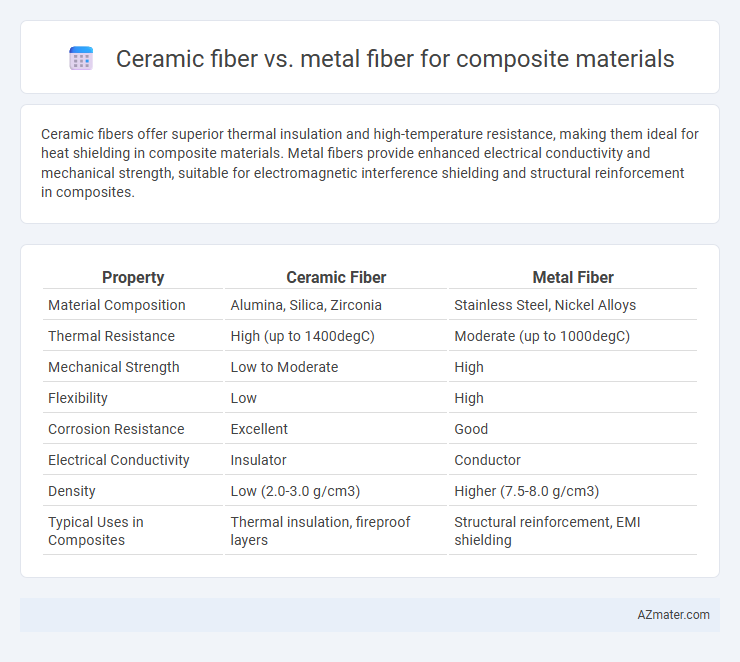Ceramic fibers offer superior thermal insulation and high-temperature resistance, making them ideal for heat shielding in composite materials. Metal fibers provide enhanced electrical conductivity and mechanical strength, suitable for electromagnetic interference shielding and structural reinforcement in composites.
Table of Comparison
| Property | Ceramic Fiber | Metal Fiber |
|---|---|---|
| Material Composition | Alumina, Silica, Zirconia | Stainless Steel, Nickel Alloys |
| Thermal Resistance | High (up to 1400degC) | Moderate (up to 1000degC) |
| Mechanical Strength | Low to Moderate | High |
| Flexibility | Low | High |
| Corrosion Resistance | Excellent | Good |
| Electrical Conductivity | Insulator | Conductor |
| Density | Low (2.0-3.0 g/cm3) | Higher (7.5-8.0 g/cm3) |
| Typical Uses in Composites | Thermal insulation, fireproof layers | Structural reinforcement, EMI shielding |
Introduction to Composite Materials
Ceramic fiber and metal fiber are critical reinforcements in composite materials, influencing mechanical strength, thermal stability, and corrosion resistance. Ceramic fibers excel in high-temperature applications due to their low thermal conductivity and exceptional heat resistance, while metal fibers offer superior electrical conductivity and ductility, enhancing toughness and impact resistance. Choosing between ceramic and metal fibers depends on the composite's intended operating environment and required performance characteristics such as thermal insulation or electrical conduction.
Overview of Ceramic Fiber
Ceramic fiber in composite materials offers exceptional thermal stability, high-temperature resistance exceeding 1200degC, and excellent chemical inertness, making it ideal for heat insulation and refractory applications. Its low density and high tensile strength contribute to enhanced mechanical performance and reduced weight in composite structures. Ceramic fibers also exhibit superior corrosion resistance compared to metal fibers, ensuring durability in harsh environments like aerospace and industrial furnaces.
Overview of Metal Fiber
Metal fiber in composite materials offers superior electrical conductivity, durability, and thermal stability compared to ceramic fibers. Its inherent ductility and resistance to cracking under mechanical stress make it ideal for aerospace, automotive, and electronic applications. Metal fibers also enhance the composite's impact resistance and facilitate efficient heat dissipation, improving overall performance in demanding environments.
Mechanical Properties Comparison
Ceramic fibers exhibit high tensile strength, excellent thermal stability, and superior resistance to oxidation, making them ideal for high-temperature composite applications. Metal fibers provide greater ductility, toughness, and impact resistance, enhancing mechanical flexibility and fatigue life in composites. The choice between ceramic and metal fibers depends on the specific mechanical demands, with ceramics favoring stiffness and thermal endurance, and metals offering enhanced toughness and deformation capabilities.
Thermal Resistance Analysis
Ceramic fiber exhibits exceptional thermal resistance, maintaining stability at temperatures exceeding 1300degC, making it ideal for high-temperature insulation in composite materials. Metal fiber, while providing good thermal conductivity and mechanical strength, typically withstands lower maximum temperatures around 800-1000degC. The choice between ceramic and metal fibers in composites fundamentally depends on the required thermal resistance and operating environment, with ceramic fibers excelling in extreme heat applications.
Weight and Density Differences
Ceramic fibers typically exhibit lower density, ranging from 2.5 to 3.0 g/cm3, making them significantly lighter than metal fibers such as stainless steel or nickel-based alloys, which usually have densities between 7.8 and 8.9 g/cm3. This weight difference is crucial in composite materials where minimizing mass enhances performance, especially in aerospace and automotive applications. The lower density of ceramic fibers contributes to improved strength-to-weight ratios and thermal insulation, whereas metal fibers provide higher electrical conductivity and malleability but at the cost of increased weight.
Corrosion and Chemical Stability
Ceramic fiber offers superior corrosion and chemical stability compared to metal fiber, with excellent resistance to acidic and alkaline environments, making it ideal for harsh chemical applications. Metal fiber tends to corrode in the presence of moisture, acids, and oxidizing agents, which can degrade the composite's structural integrity over time. Composite materials reinforced with ceramic fibers maintain their performance and durability in aggressive chemical conditions, extending service life in industrial and high-temperature applications.
Cost and Availability Factors
Ceramic fibers generally have higher manufacturing costs due to energy-intensive processing and limited raw material sources, making them less economically viable for large-scale composite production. Metal fibers, often derived from abundant metals like steel or aluminum, offer lower costs and wider availability, enhancing their appeal for cost-sensitive composite applications. Supply chain stability for metal fibers typically surpasses that of ceramic fibers, ensuring more consistent material access for manufacturing.
Typical Applications in Industry
Ceramic fiber composites are predominantly used in high-temperature insulation, thermal barriers, and furnace linings in industries such as aerospace, automotive, and power generation due to their excellent heat resistance and low thermal conductivity. Metal fiber composites find typical applications in electromagnetic shielding, filtration, and heat exchangers within electronics, chemical processing, and environmental technologies because of their superior electrical conductivity and structural strength. Both materials are integral in advanced manufacturing processes, with ceramic fibers excelling in thermal management and metal fibers providing mechanical durability and electrical functionality.
Selecting the Optimal Fiber for Your Composite
Ceramic fibers provide exceptional thermal resistance and chemical stability, making them ideal for high-temperature composite applications such as aerospace and industrial insulation. Metal fibers offer superior electrical conductivity and mechanical strength, suited for composites requiring enhanced structural integrity and electrical pathways, like automotive and electronic components. Selecting the optimal fiber depends on balancing factors such as operating temperature, mechanical load, corrosion resistance, and electrical conductivity to meet specific composite material performance requirements.

Infographic: Ceramic fiber vs Metal fiber for Composite material
 azmater.com
azmater.com